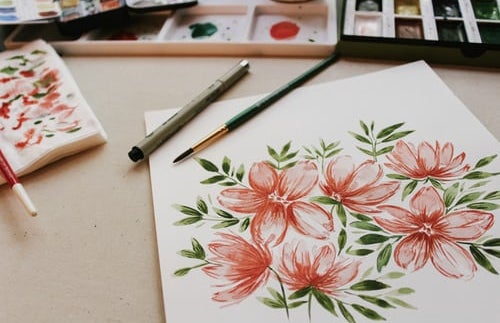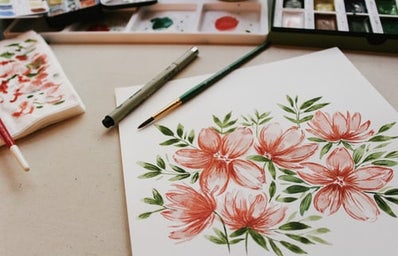Who says art has to be serious? For those of us who do not pursue art as a profession, our efforts to make art later in life tend to get blocked by inhibitions such as “I’m not good at it” or “it’s too much of an effort to start”. Some of us might have liked drawing in the past before getting the bout of not-good-enough – whereas others may be distracted by childhood art class memories of awkward blobby drawings and watercolours ruining the paper.
But art is a good “lockdown hobby” and a stress reliever. While you could splurge on more expensive art supplies, it is easy to get started with any trusty felt tip ink pen. The very cheapest pencils for kids crafts are sometimes of poor quality for anything beyond basic practice, but even a reliable and low-end pen and pad for hobbyists should get you going.
When your workspace and supplies are ready, there is still the hurdle of getting going. Luckily, there are solutions to the scenarios.
- “I want to draw, but I’m bad at it”.
-
First off, who gets to decide whether you are bad at it? Even if you are, that should not be a reason to avoid doing something you enjoy. Accept that art can be for your own enjoyment, not to show off. But if you feel like you have an art idea or maybe art supplies you’d like to try out, there are tutorials on YouTube for basically every medium, from watercolours to digital art, from charcoal to Chinese ink brush. There are also helpful tips for choosing supplies, such as getting the right paper density to avoid wrinkling any wet medium project. Not to mention, there are tutorials for drawing specific things, such as landscapes, animals, plants, portraits in both realistic and semi-realistic styles… If you happen to own oil paints, there are quite a few Bob Ross tutorials on YouTube – talk about art as self-care!
- “I can’t draw and I’m too busy to learn.”
-
Art is not just about drawing or painting good likeness. It could be about matching nice colours together. Finding interesting shapes. Symbolic or abstract patterns. Enjoying the satisfaction of a thick brush stroke on textured paper. Think about a colouring book for adults – they are a stress relief method, but also a way to enjoy different colours coming together, bit by bit, pencil stroke by pencil stroke. Even your lecture doodles can become an artwork if you ink and colour them with care. The result does not have to portray anything in particular – or it can be a composition of small pictures, perhaps arranged into an interesting collage.
- “I don’t have the time to draw.”
-
This is a common reality – with many projects, we feel that we just do not have the time. If you are working with paints or anything else that needs to be wet or requires time to dry, it might not even be possible to work on your art in short spurts. However, some art exercises are specifically made to be completed in a short span of time. For example, you could challenge yourself to draw as much as you can in 5 minutes – no more, no less, without going back to make changes. Little by little, you might get into a routine, and drawing regularly, even if it is only in short spurts, will become easier.
- “I have the time to draw, but I can’t find the inspiration.”
-
All artists have been there: when you have the inspiration, you don’t have the time, and when you have the time, you don’t have the inspiration. If you want to create original art beyond what is in the tutorials, you have to come up with your own ideas. Listening to music could get you into creative mode. Or you could make art based on a reference that you find in your room or on Instagram, for example. If you want to try croquis, i.e. quick sketching (nude) models, you can get references without even having to sign up for an art class. Try out web resources such as ArtModelTips and Croquis Cafe (NSFW due to model nudity).
For less serious topics, try fan art. Isn’t it kind of cringey tho, some might be thinking, to be drawing my celebrity crush or favorite character? Well, you could just think of that celebrity crush as another photo reference. As for fan art for your favourite book, game or television show, that is simply you illustrating the story – isn’t a significant portion of Western classical art simply fan art for the Bible? Drawing your take on a scene from your current fictional obsession has the advantage that you are invested in the motif and perhaps willing to explore different sides to the story. The most interesting fan art is perhaps based on a non-visual medium such as a book, in which case you can draw a character, a setting or a scene from your own imagination, unrestricted by the “official” visuals.
Hopefully, these tips will help you channel your artistic inspiration. If you want to become a great artist, you will have to work hard for it. You will have to diligently practice outside of your comfort zone, critically evaluate your efforts and learn art theory, all while working to find your own artistic style, something that makes your art yours. But as a hobbyist starting out, you don’t have to aim for greatness. Painting or drawing as a hobby does not have to be serious, and even if you choose not to draw, it should not be because you think you are not good enough.
Or are you more of a writer? Dried up inspiration is a common enemy, but you can check out our tips for tackling Writer’s Block.



